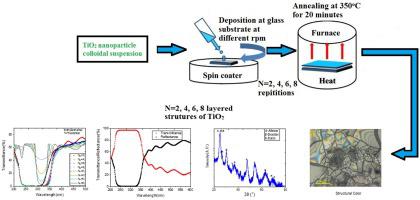Materials Today Communications ( IF 3.7 ) Pub Date : 2020-06-22 , DOI: 10.1016/j.mtcomm.2020.101367 Ankit Singh , Ankur Gupta , Akhilesh Tiwari , Pramod Kumar

|
An experimental realization of a new type of one-dimensional photonic crystal has been proposed, based on the periodic layer-by-layer structure of TiO2. The multilayer deposition of TiO2 nanoparticle colloidal suspension forms a periodic arrangement of a one-dimensional photonic crystal. It has been able to control and block well defined unwanted radiation or selective harm UV radiation. The fundamental property of photonic crystals is their Photonic bandgap (PBG), which is to be around "225nm<λ<350 nm", and also exhibit structure colour properties. Periodic multilayer structures of TiO2 on a glass substrate have been deposited by spin coating technique, at different rpm, which affects the thickness of subsequently deposited layers and effective refractive index. FESEM provides a cross-section image of deposited structure for eight layers and thickness, which is in good agreement of calculated one by a profilometer. The X-ray diffraction pattern shows the growth of the epitaxial surface as well as the generation of phase junctions (i.e., the formation of anatase, rutile, and brookite phases of TiO2). Due to these formations, the proposed structure in this study has less number of the defects, and so, there is a low loss in light propagation. Experimental and theoretical analysis of transmittance spectra in the UV region is done by UV–vis spectrophotometer and MATLAB based program, respectively. This technique may be used for developing several applications having excellent photocatalytic properties as well as for photonic crystal device formation.
中文翻译:

一维光子晶体中TiO 2外延生长的异质集成:实验和理论分析
基于TiO 2的周期性逐层结构,提出了一种新型的一维光子晶体的实验实现。TiO 2纳米粒子胶体悬浮液的多层沉积形成一维光子晶体的周期性排列。它已经能够控制和阻止定义明确的有害辐射或选择性伤害UV辐射。光子晶体的基本性质是其光子带隙(PBG),其约为“ 225nm <λ<350nm”,并且还表现出结构颜色性质。TiO 2的周期性多层结构已经通过旋涂技术以不同的rpm沉积在玻璃基板上的表面上,这影响随后沉积的层的厚度和有效折射率。FESEM提供了八层和八层厚度的沉积结构的横截面图像,与轮廓仪计算得出的图像非常吻合。X射线衍射图显示了外延表面的生长以及相连接的产生(即,TiO 2的锐钛矿相,金红石相和板钛矿相的形成))。由于这些形成,本研究中提出的结构具有较少数量的缺陷,因此光传播损失低。通过紫外可见分光光度计和基于MATLAB的程序分别对紫外区域的透射光谱进行了实验和理论分析。该技术可以用于开发具有优异的光催化性能的几种应用以及用于光子晶体器件的形成。











































 京公网安备 11010802027423号
京公网安备 11010802027423号